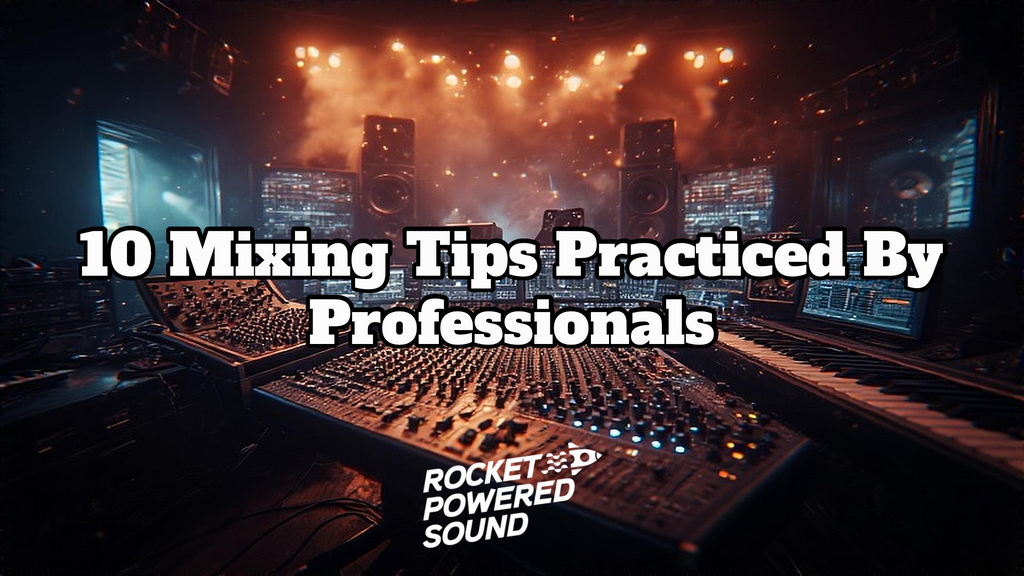10 Mixing Tips Practiced By Professionals

We’ll be sharing with you ten mixing tips that will help you bring your mixes to the next level.
#1 Use A Reference Track
When starting out, a reference track can be really useful. Find a song that similar to what you’re going for, import it into your DAW, and compare it to your mix to get an idea of how each element should fit into the mix. Use EQ to roll off frequencies to focus in on the part of your mix that you’re working on. (For example, if you’re working on the bass, roll off the higher frequencies. If you’re working on high hats, roll off the low/mid frequencies…)
#2 Know Your Tools
There are some great plugins out there, some of which cost money. It’s important to remember that in order to get the most out of these plugins and to really have them be worth the money, you should understand the basics of what they do. For example, you probably want to know the ins and outs of the stock compressor in your DAW before spending a bunch of money on a compressor plugin.
#3 Check Your Mix in Mono
Sometimes, in the stereo field, something called “phase cancellation” will occur. If you don’t know what that is, it’s basically where one sound wave is at its peak and another is at its trough, and they cancel each other out. This can happen in the stereo field, and so it’s good to check for this in mono. Also, our brains can become distracted by the stereo, and by switching to mono from time to time, we can focus on what we really need to hear in the mix. In Ableton, you can do this by placing the Utility plugin on the Master channel, and clicking the “Mono” button. You could even assign a key to this function to switch back and forth easier.

#4 Take Breaks
Your ears get tired—it’s good to give them a rest every once in a while, so that you can come back and notice things that you didn’t before. It is very important to re-listen to your track with fresh ears. It is also possible to listen to other tracks, from different music styles, while on your break.
#5 Side-Chain Compression
Side-Chain compression can be good for things like balancing your kick-bass relationship, or getting a snare to cut through the mix. Basically, side-chain compression will make one signal duck when the other one hits.

#6 Splitting Bass
Having a dedicated track for your Sub Bass can be a game changer. For example, if you feel that the low end is lacking some punch, splitting up your bass would allow you to bring up your sub rather than all of your bass—or maybe you want to make some tweaks to some of the upper frequencies while keeping the sub bass clean. You can do this by duplicating your bass track and rolling off the lower frequencies on one track and the higher frequencies on the other.
#7 Sends
There are a few reasons you’d want to utilize send channels: Maybe you want several elements of your mix to have the same reverb or delay. Maybe you want to process your effects differently than your dry or main signal. It’s also a great way to save on CPU power. In Ableton Live you can do this by right clicking, and selecting “Insert Return Track”. You can add your effects on the return track and turn up the send knob on each track you want to send to it. Other DAWs have similar ways to acheieve that.

#8 Spectrum Analyzer
Sometimes it’s helpful to get a visual representation of your sound. This is where Spectrum Analyzers can be useful. It can help you identify unwanted frequencies or resonance problems—or maybe you just want to have a visual representation of the tonal balance of your mix. SPAN is a popular (and free!) spectrum analyzer plugin. You check that out here. Most DAWs offer stock spectrum analyzers which you can use as well.

#9 High-Pass Filter
Utilizing a high-pass filter to free up space in the low-end and get rid of muddiness. A lot of the time, some of your tracks will have low-frequency rumble that is not important or is inaudible. That’s why it’s a good idea to high-pass most, if not all, of your tracks besides your Kick and Bass. Just be careful not to go too far with it.

#10 Contrast
What’s loud without quiet? What’s high without low? Wide without narrow? Full without empty? Everything in your mix is heard within the context of what’s around it. If you want something in your mix to sound particularly wide, make the things around it narrower. Silence before a drop. Making use of contrast in a mix can really make things interesting.
If you're an Ableton Live user and would like to receive weekly professional workflow and production tips, sign up for the "Ableton Cookup" newsletter. It's FREE!
Sign Up: https://t.co/JVcOxToF58






